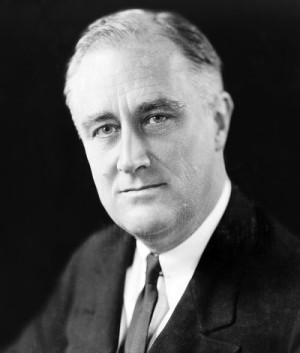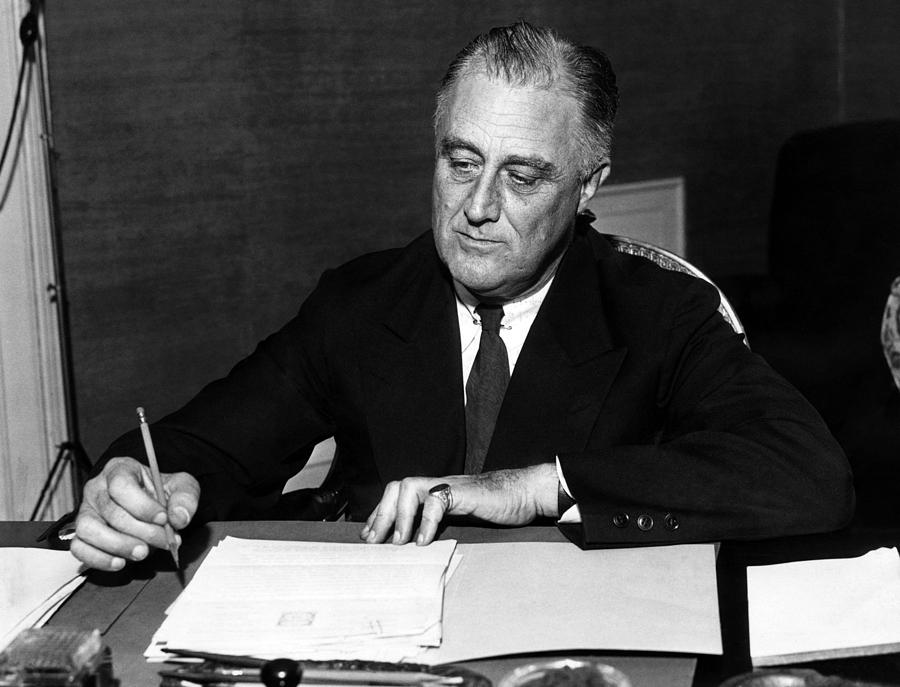Franklin D Roosevelt (Franklin Delano Roosevelt)

Franklin D Roosevelt
Franklin Delano Roosevelt (January 30, 1882 – April 12, 1945), commonly known by his initials FDR, was an American statesman and political leader who served as the 32nd President of the United States. A Democrat, he was elected four times and served from March 1933 to his death in April 1945. He was a central figure in world events during the mid-20th century, leading the United States during a time of worldwide economic depression and total war. A dominant leader of the Democratic Party, he built a New Deal Coalition that realigned American politics after 1932, as his New Deal domestic policies defined American liberalism for the middle third of the 20th century.
Roosevelt was born in Hyde Park, New York in 1882 to a prominent New York family. He attended Groton School and Harvard College, graduating in 1903. In 1905, he married Eleanor Roosevelt, with whom he had six children. He entered politics in 1910, serving in the New York State Senate, and then as Assistant Secretary of the Navy under President Woodrow Wilson. In 1920, he was the Democratic nominee for Vice-President of the United States, but was defeated by Calvin Coolidge. Roosevelt was stricken with polio in 1921, which cost him the use of his legs and put his political career on hold for several years. After returning to political life by placing Alfred E. Smith’s name into nomination at the 1924 Democratic National Convention, Roosevelt was asked by Smith to run for Governor of New York in the 1928 election. Roosevelt served as a reform governor from 1929 to 1932, and promoted the enactment of programs to combat the Great Depression that occurred during his governorship.
Roosevelt defeated incumbent Republican Herbert Hoover in November 1932, at the depth of the Great Depression. Energized by his personal victory over polio, FDR used his persistent optimism and activism to renew the national spirit. Assisted by key aide Harry Hopkins, he worked closely with British Prime Minister Winston Churchill and Soviet leader Joseph Stalin in leading the Allies against Nazi Germany, Fascist Italy and Imperial Japan in World War II.
In his first hundred days in office, which began March 4, 1933, Roosevelt spearheaded major legislation and issued a profusion of executive orders that instituted the New Deal—a variety of programs designed to produce relief (government jobs for the unemployed), recovery (economic growth), and reform (through regulation of Wall Street, banks and transportation). The economy improved rapidly from 1933 to 1937, but then relapsed into a deep recession. The bipartisan Conservative Coalition that formed in 1937 prevented his packing the Supreme Court. For the rest of his days in office, it blocked all proposals for major liberal legislation (apart from a minimum wage law). It abolished many of the relief programs when unemployment practically vanished during the war. Most of the regulations on business continued in effect until they ended about 1975–1985, except for the regulation of Wall Street by the Securities and Exchange Commission, which still exists. Along with several smaller programs, major surviving programs include the Federal Deposit Insurance Corporation, which was created in 1933, and Social Security, which Congress passed in 1935.
As World War II loomed after 1938, with the Japanese invasion of China and the aggression of Nazi Germany, Roosevelt gave strong diplomatic and financial support to China and Great Britain, while remaining officially neutral. His goal was to make America the “Arsenal of Democracy,” which would supply munitions to the Allies. In March 1941, Roosevelt, with Congressional approval, provided Lend-Lease aid to the countries fighting against Nazi Germany with the United Kingdom. With very strong national support, he made war on Japan and Germany after the Japanese attack on Pearl Harbor on December 7, 1941, calling it a “date which will live in infamy”. He supervised the mobilization of the U.S. economy to support the Allied war effort. As an active military leader, Roosevelt implemented an overall war strategy on two fronts that ended in the defeat of the Axis Powers and the development of the world’s first nuclear bomb (commonly called the atom bomb at the time). In 1942 Roosevelt ordered the internment of 100,000 Japanese American civilians.
During the war, unemployment dropped to 2%, relief programs largely ended, and the industrial economy grew rapidly to new heights as millions of people moved to new jobs in war centers, and 16 million men and 300,000 women were drafted or volunteered for military service. All economic sectors grew during the war. Farm output went from an index (by volume) of 106 in 1939 to 128 in 1943. Coal output went from 446 million tons in 1939 to 651 in 1943; oil from 1.3 billion barrels to 1.5 billion. Manufacturing output doubled, from an index of 109 in 1939 to 239 in 1943. Railroads strained to move it all to market, from an output of 13.6 billion loaded car miles in 1939 to 23.3 in 1943. However, Roosevelt’s health seriously declined during the war years, and he ultimately died three months into his fourth term while vacationing at the polio treatment center he established at Warm Springs, Georgia.
Roosevelt dominated the American political scene during the twelve years of his presidency, and his policies and ideas continued to have significant influence for decades afterward. He orchestrated the realignment of voters that created the Fifth Party System. Roosevelt’s New Deal Coalition united labor unions, big city machines, white ethnics, African Americans, and rural white Southerners. His work also influenced the later creation of the United Nations and Bretton Woods. Roosevelt is consistently rated by scholars as one of the top three U.S. Presidents, along with Abraham Lincoln and George Washington.
Born
- January, 30, 1882
- Hyde Park, New York
Died
- April, 12, 1945
- Warm Springs, Georgia
Cause of Death
- cerebral hemorrhage
Cemetery
- Franklin D. Roosevelt National Historic Site
- Hyde Park, New York



